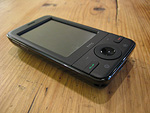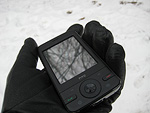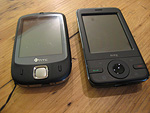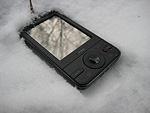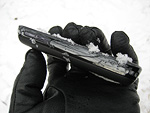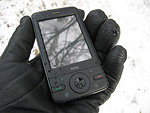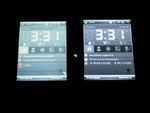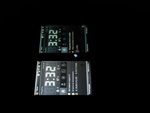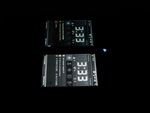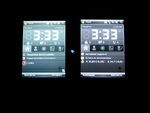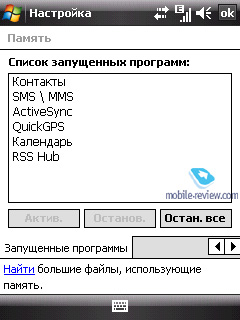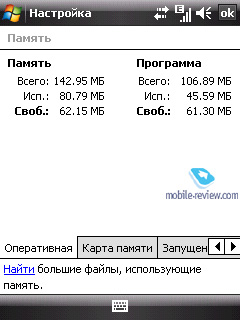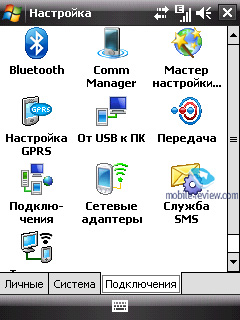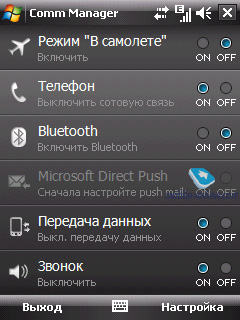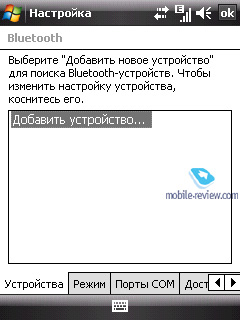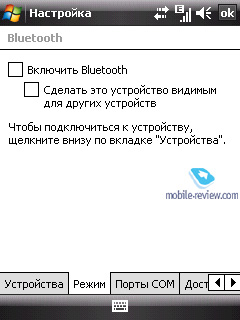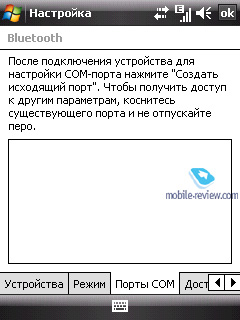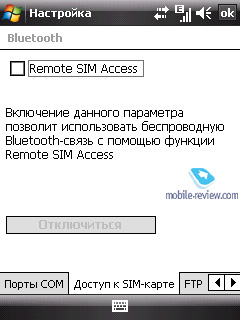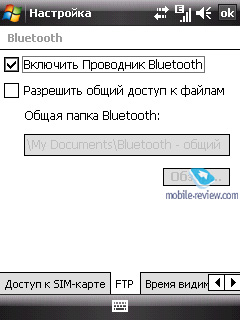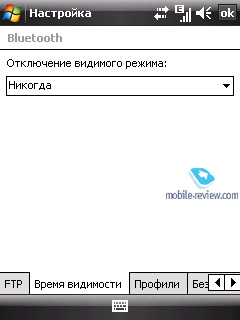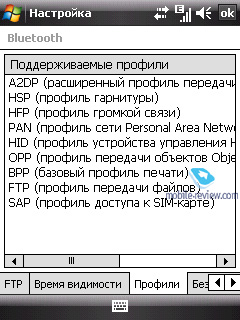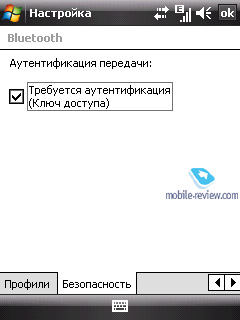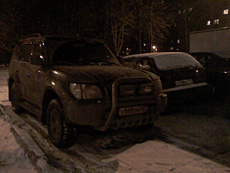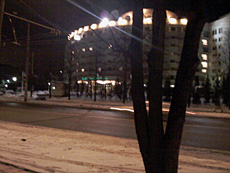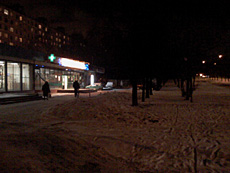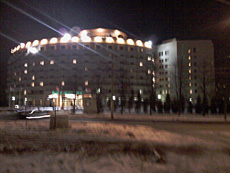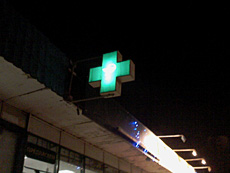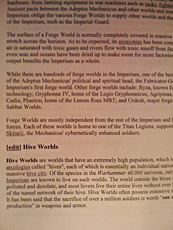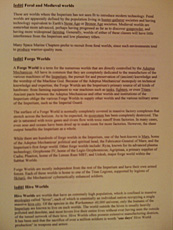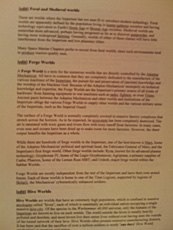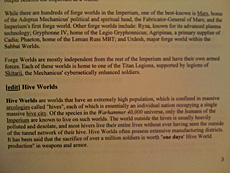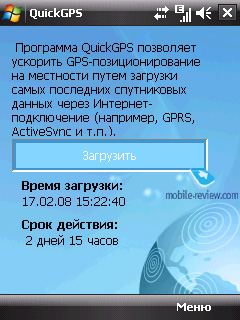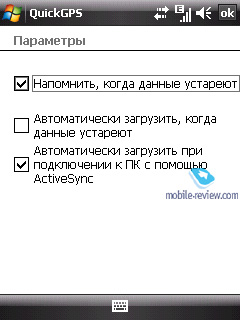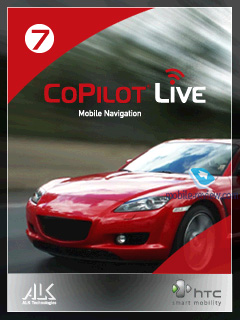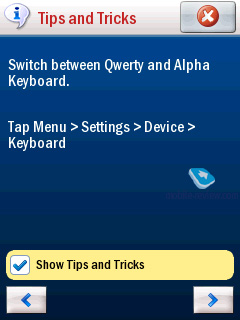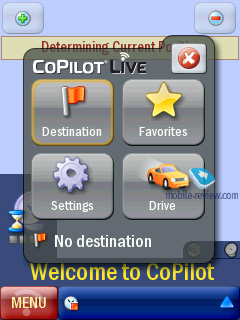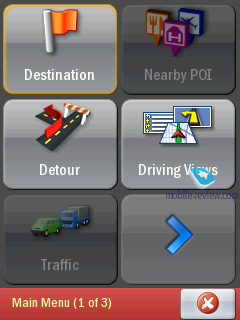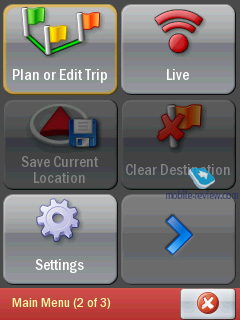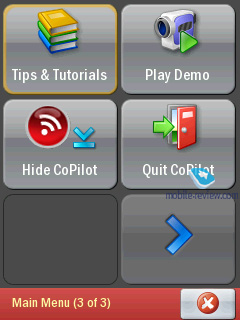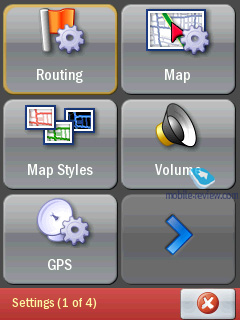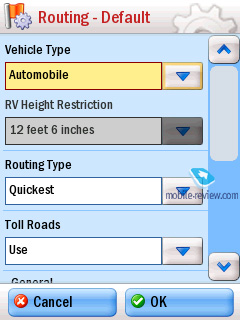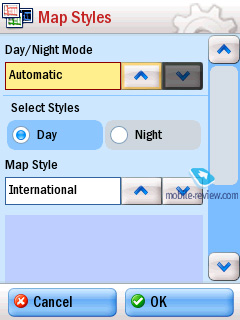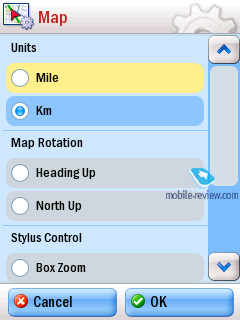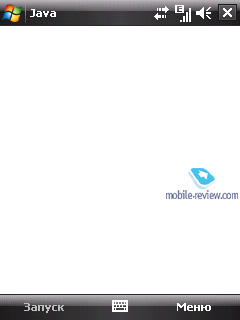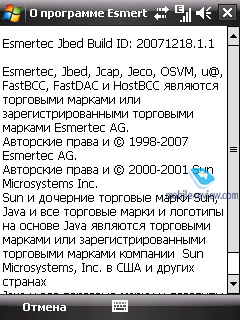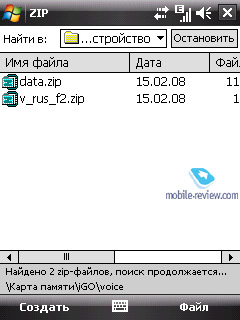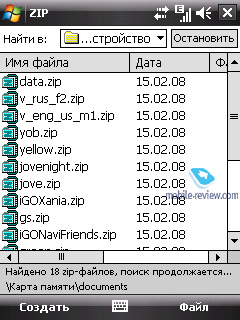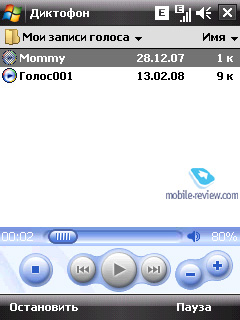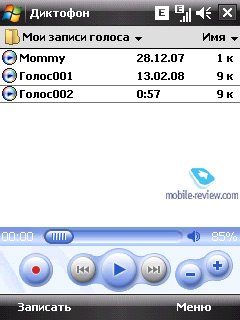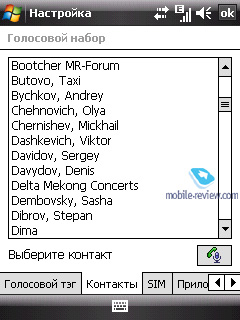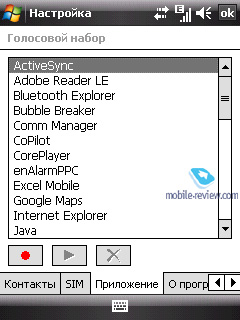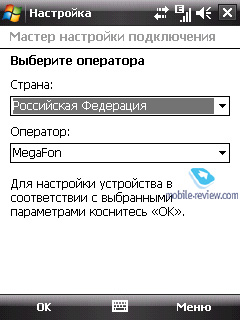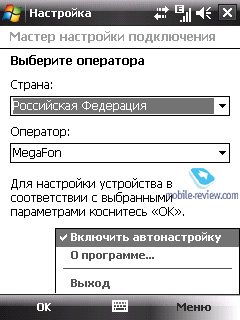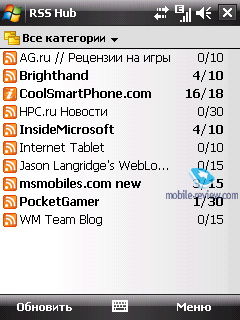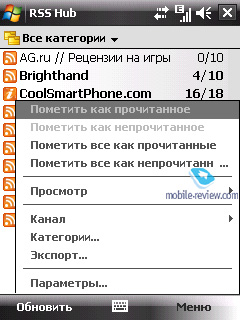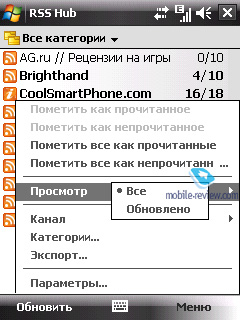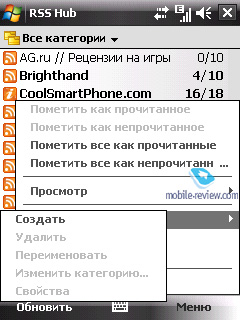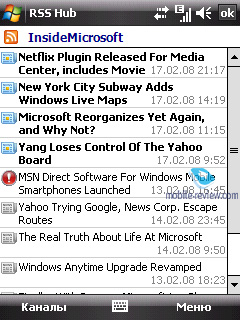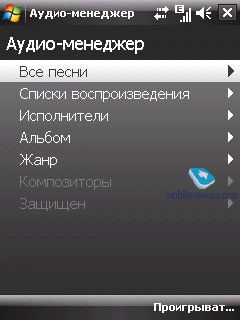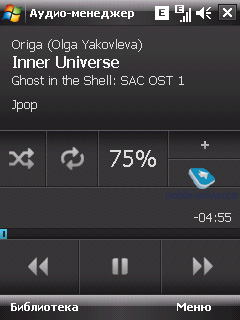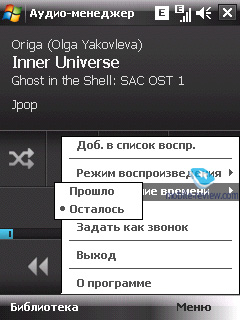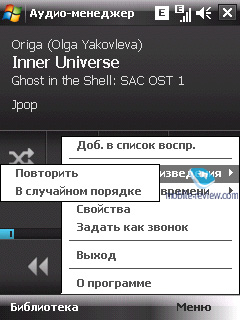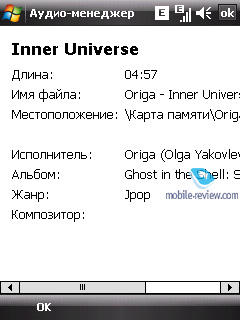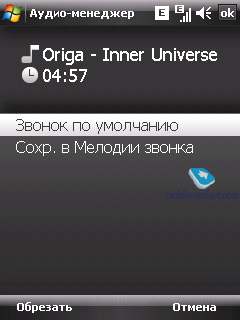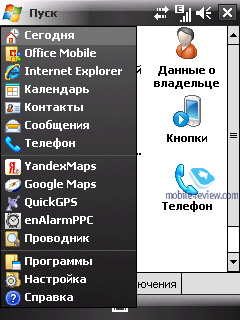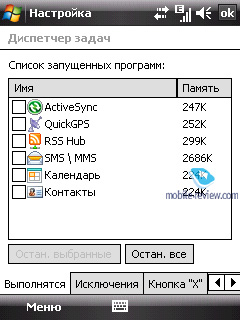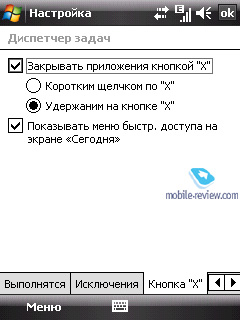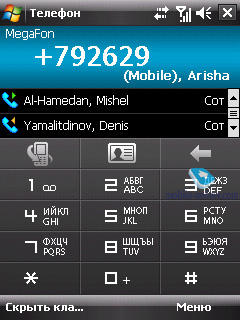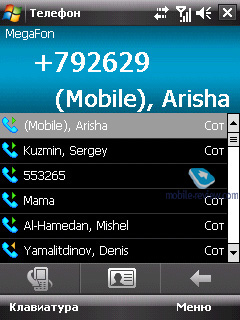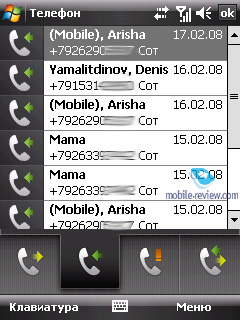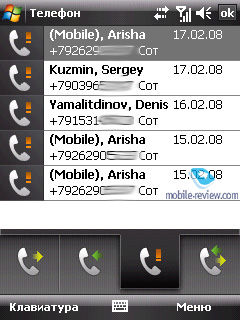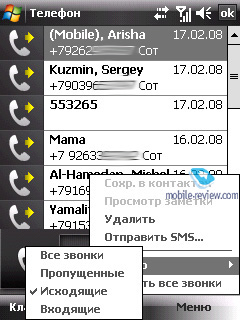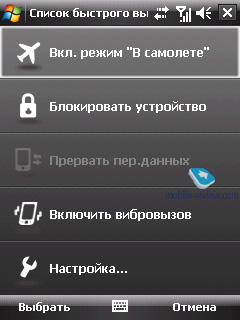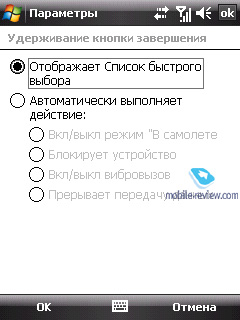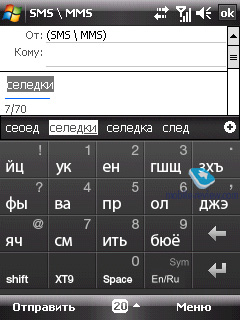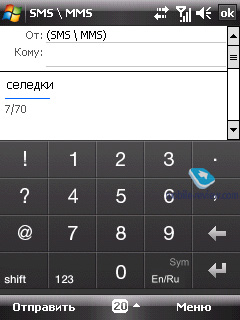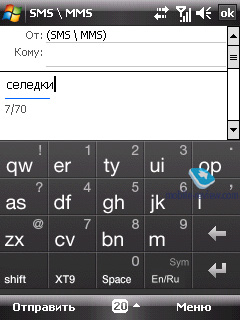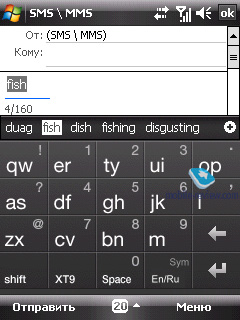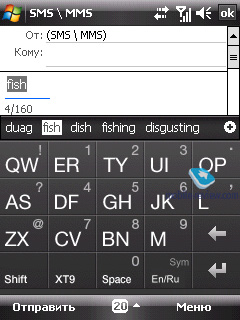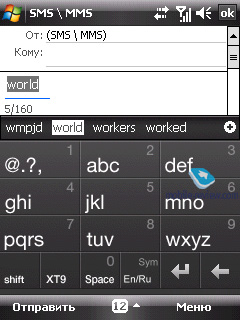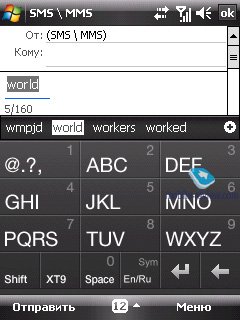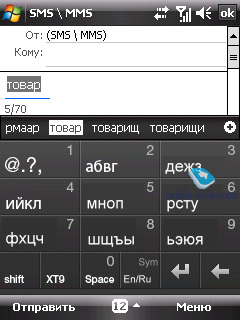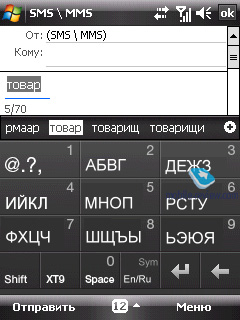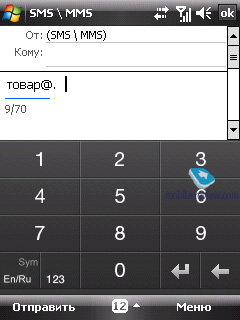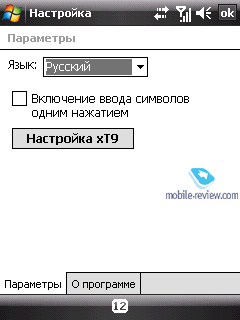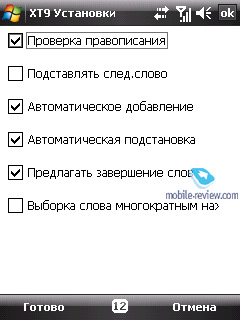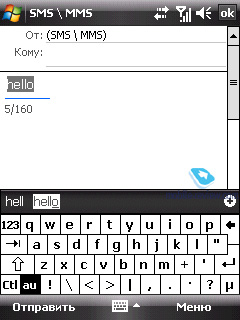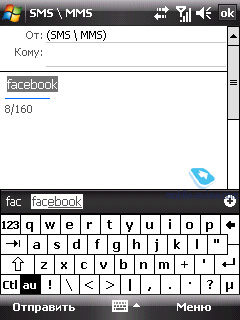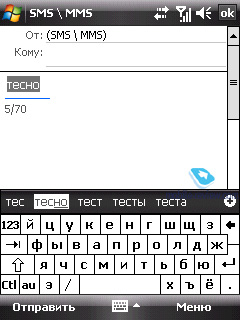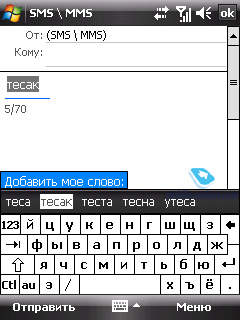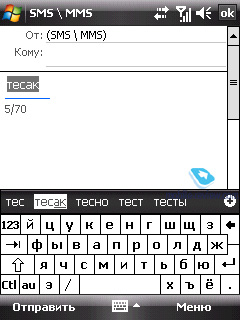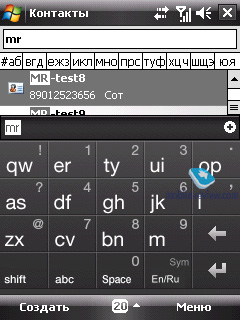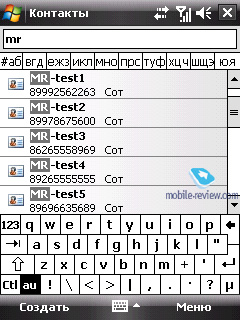Review of GSM-communicator HTC P3470 (Pharos)
Live photos of HTC P3470
Table of contents:
- Positioning
- Design
- Size
- Controls
- Navigation cluster
- Display
- Battery time
- Performance
- Connectivity
- Camera
- GPS navigation
- Software
- Competition
- Conclusion
Sales package
- Communicator
- miniUSB data cable
- Charger
- Holster
- Wired stereo-headset
- Software CD
- User Guide
Positioning
As far as the HTC P3470’s positioning goes, there are several points of view, which are, in effect, all correct (to a certain extent) and have every right to exist. However, closer inspection of the P3470 allows figuring out its true place in the maker’s portfolio.
If you look at the HTC P3300 (Artemis) which is on sale even these days, and then put the P3470 and the Touch Cruise next to it, you will surely notice this thing: the maker seemingly took the ideas and functionality that underpin the P3300 and then threw certain feats into two different models – the more entry-level P3470 and the high-end Touch Cruise.

But if go deeper into their respective places on the market and price tags, the big picture will get a little bit different. It has been already over 1,5 years since the day the P3300 hit the shelves, and HTC definitely has definitely put a lot of hours into studying the success of this phone and what the prospects of its concept are. So, basically, it would have been utterly unwise of HTC to split a sought-after device into two, especially given the level of sales currently observed in the Windows Mobile market, where no manufacturer can expect a whole array of devices to generate decent numbers. Putting it simply, HTC has to know better that its offerings will never be equally popular.
This way, the HTC Touch Cruise is, to some extent, a high-end edition of the P3470. Now that the P3470 has finally debuted, it is clear what HTC’s true intentions are. The Touch Cruise, along with the TyTN II constitute their premium segment, neither of them is the maker’s shock troop in terms of sales. In effect, they have been rolled out just for the sake of HTC’s image as the market’s leading company, packing in pretty much uncompromised functionality with rich design, top-notch build quality and hefty price tags. These communicators don’t make most of the vendor’s sales, and what’s more, they have never been meant to, that’s why they allow for such stratospheric premiums for them, touting how “elite” they are.

And what about a successor to the P3300? That’s where we bump into the P3470, which is little to no different from the original P3300 and comes in with a comparable price tag, being positioned as an affordable GPS-enabled solution. In reality, it actually is the way to go for those who still have the P3300, HTC’s most popular offering, in their pockets. It doesn’t take a rocket scientist to figure out that the vast majority of its adopters are mobile enthusiasts not particularly keen, if at all, on this operating system’s philosophy, and rather employ their communicators for calls, navigation and a couple of other purposes.
This is the target audience the new P3470 takes a shot at – it ditches Wi-Fi that the average Joe doesn’t deem an essential feature, and improves in terms of the core functionality, having almost all feats of the touchphone series under the hood.

Back to the table of contents >>>
Design
HTC appreciated the following garnered by the P3300 and in many ways have replicated its design in the P3470 – even the layout of controls is pretty much identical. In this sense, the P3470 is a thorough overhaul of the P3300, despite not breaking the succession line design-wise. The newcomer enjoys a more no-nonsense design with no ornamental insets and an all-black color scheme.

The streamlined shape of the P3470 feels good in the hand, with both ends and spines smoothly flowing into the back cover, just like in the more entry-level HTC P3400.
It seems that HTC is once again right on with its versatile design that will appeal to most consumers. The P3470 doesn’t look cheap of low-end, and doesn’t sway towards men or women at that.

As far as tactile feel and ergonomics are concerned, the P3470’s pool of materials is great. The front fascia utilizes slightly rough black plastic with a barely noticeable silver coating that has no propensity to collect fingerprints or expose skin-deep scratches. The flanks are decked out in glossy mirrorish plastic, while the rear, including the lips of the phone’s spines, is finished in soft-touch plastic that feels more on the velvety side. The same type of plastic is used in the navigation key, but we’ll look into it in detail below.


Despite adopting a lot of features from the touchphone series, the P3470’s display is recessed into the casing, which is quite strange, since some applications get fiddly to handle with fingers this way, and it wasn’t a rare occasion when we were forced to pull out the stylus to move about the communicator.
The P3470’s display is nearly the only part of the casing that picks up fingerprints and ear grease after calls. Since it is not mounted flush with the rest of the casing, its corners keep accommodating dust, which is quite a pain to clean out. The same holds true for the camera lens that has no cover and thus attracts dirt and mud.

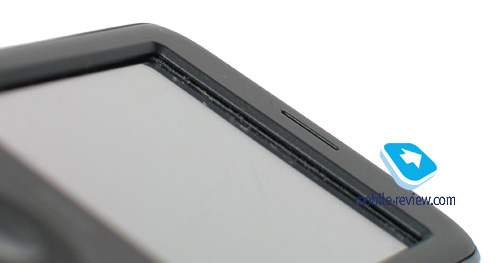
Back to the table of contents >>>
Size
Size-wise, the HTC P3470 is a no-frills communicator – it is neither the most pocketable device we have seen, nor the bulkiest handset around. All in all, its design meshes pretty well with dimensions, given its display diagonal and controls.


Let’s see how the P3470 fares against other communicators dimensions-wise:
- HTC P3470 – 108x58.5x15.7 mm, 122 g
- HTC P3300 – 108x58x16.8 mm, 115 g
- Mio A502 – 96x60x21 mm, 135 g
- Glofiish X600 – 107x58x14.7 mm, 136 g
It turns out, the P3470 is little to no different from the competition as far as size is concerned and its weight is pretty standard too.







Back to the table of contents >>>
Controls
While most controls are laid out in a traditional fashion (except for the navigation cluster found under the display), some elements have been moved to other places in the P3470, as compared to other HTC-branded solutions. Topping the display on the front plate is the earpiece covered by a grill, recessed into the casing, and flanked by two LEDs.

The one on the left glows in green or orange, warning the user of active GSM- and UMTS-modules (green) and new messages, notifications, low battery (orange). The LED on the right springs into life with blue whenever you have the Bluetooth module or GPS enabled.
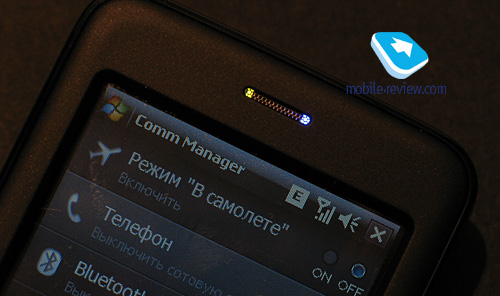
The right-hand side would have been bald if it wasn't for the dedicated camera button (tap and hold to start up the application, click to take a photo). The key sits slightly above the surface, and in general handles well, however we have a small niggle with it – when holding the P3470 in the right hand and trying to turn it off (the display on/off button), you palm will inevitably jam the camera key, so often enough after enabling the display you will find yourself not at the Today screen, but in the camera application instead.

Positioned more towards the lower end of the right-hand flank is tight stylus silo. The stylus’s handle has a ledge, which you can hook to pull it out of its nest.


The stylus coming with the P3470 is non-extendable, although it is not a big deal –tiny length is offset by its convenient thickness.
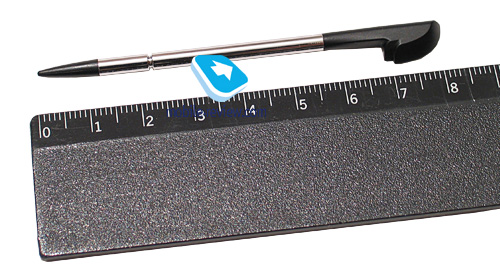
Perched on the top of the left-hand side is the volume rocker, which is mounted flush with the casing, which makes it hard to tap by feel.


The bottom end of the left spine features the lanyard eyelet.

The soft reset button is mounted on an unusual place – to access it, you will have to detach the battery cover. We found it was better to press it with the tip of the stylus.
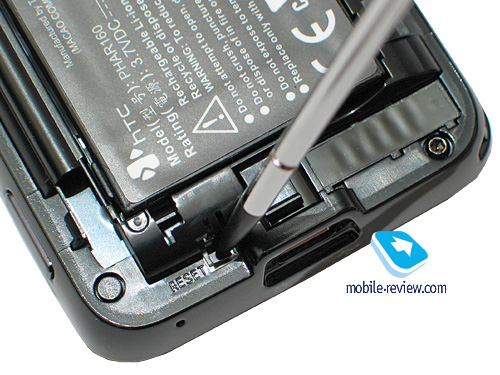
Bad news for the proud owners of the HTC P3300 – the new communicator is no different from its predecessor as far as the memory expansion slot’s placement goes, meaning that it still nests underneath the battery (doesn’t seem to be a very contemporary layout), so no hot-swap in the P3470 either. The communicator deals with microSD (SD 2.0) memory cards of any size.
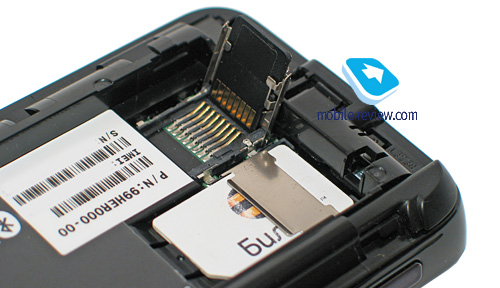
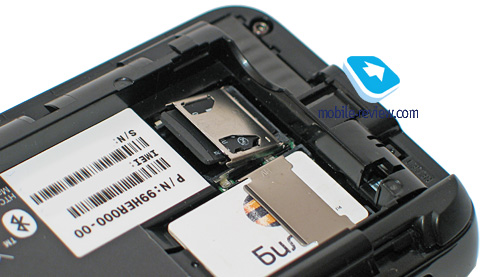
The SIM-card slot is placed right next to the memory card socket.
Mounted more towards the top of the P3470’s underside is the antenna slot covered by a grommet, doubling as a self-portrait mirror that is easy to remove.




The top end of the communicator rooms the power button that can also disable the display (short press), the curve where the top edge blends with the rear houses the loudspeaker for ring tones.

The bottom edge sports the ExtUSB socket for data cables, chargers and headsets. Perched next to this slot is the microphone.

The battery compartment cover occupies the entire real estate of the P3470’s underside, that should be pulled up in order to access the slots for SIM- and microSD-cards. The cover is pretty tight and it doesn’t seem it can come loose with time.
Back to the table of contents >>>
Navigation cluster
In a way, the P3470’s navigation array is similar to that of the P3300 – while the layout is different, the trademark feature of the P3300, the navigation wheel, is still here. Naturally it has undergone some changes, but it is more of an improvement.


The center key is mounted within the wheel, and is made of plastic. Thanks to the dent in it, this button is easy to handle, though you have to feel it yourself – off the top of my head, only the Click Wheel in iPods delivers a similar tactile feel.
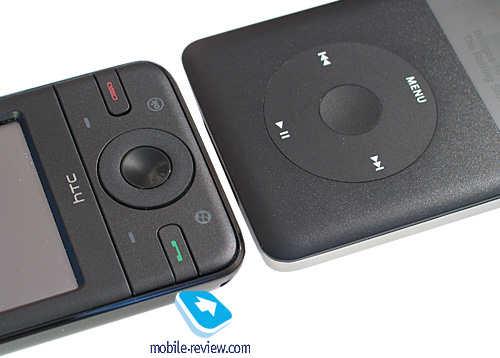
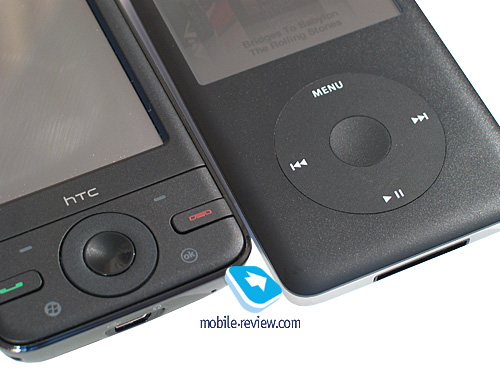
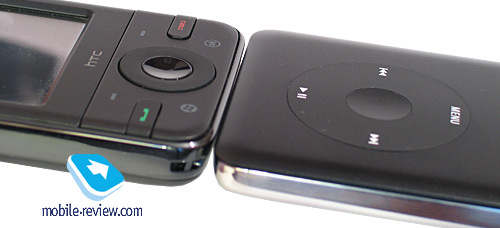
The navigation wheel itself is made of soft plastic and spins back and forth with ease, which is somewhat inconvenient, but you’ll get used to it in almost no time. Apart from scrolling through lists, texts and web pages, it also doubles as a navigation pad with four directional buttons embedded into it.


Even though the wheel is quite tiny, people with big hands won’t experience any nuisances with it.



The pick/hang up buttons, much like the wheel, stick out of the casing a little; but they aren’t as convenient – obviously HTC has gone for style over usability with them.


The fact is, they are too thin, and on top of that are placed between other buttons, so you are likely to touch the keys around them, like Start or OK. That’s why answering calls is more painless when using the left soft-key.
Thanks to packing in conventional soft-buttons, as well as the Start and OK keys, the P3470 is a breeze to move about. If it weren’t for these fiddly pick/hang up keys, it would’ve been flawless. The navigation cluster is lit in reasonably bright white; neither the wheel nor the center button is backlit, though.
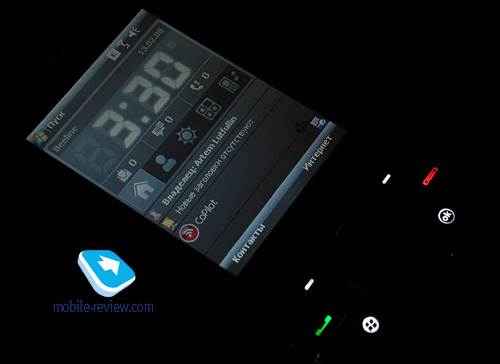
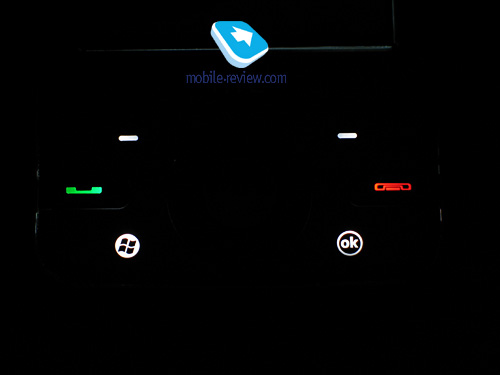
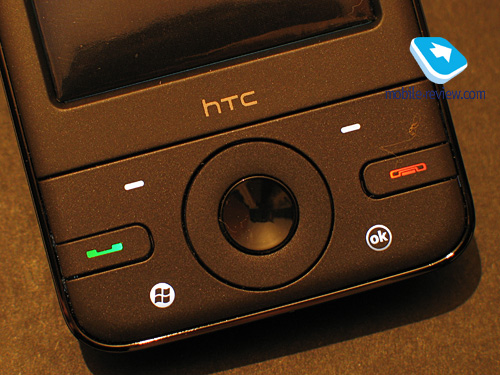
All keys, except the one in the center, the wheel and soft-buttons, can be reprogrammed via the operating system’s standard settings.
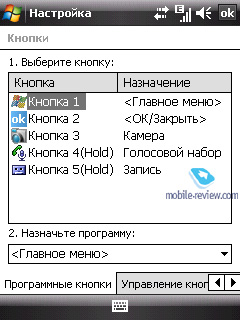
Back to the table of contents >>>
Display
The P3470 comes equipped with a touch-sensitive 2.8-inch TFT matrix (58x43.5mm, 320x240-pixel resolution) that displays up to 65 K colors. Spec-wise, this screen is very little different from the entry-level P3400.
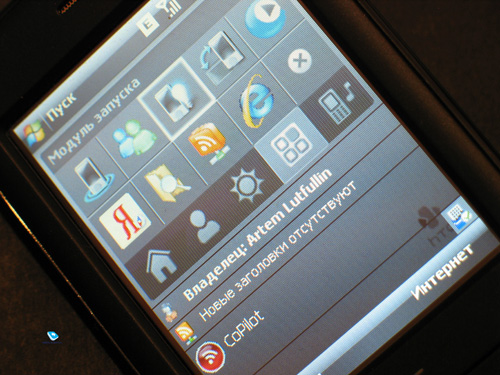
The viewing angles (vertical and horizontal) are quite meager, putting the P3470 in one boat with the most basic solutions on this front; even communicators from E-Ten, Mio and Asus offer better viewing angles. Anyway, HTC has been employing this matrix only in the most unsophisticated models so far. Also, keep in mind that viewing angles have nothing to do with brightness and sharpness of the display, which are a standard Windows Mobile fare here.
This screen’s real weak spot is the way it handles direct sunlight - it gets completely washed out to the extent when you can’t see a thing on it, so you will have to adjust and try to find a better angle. However, this issue is typical for all Windows Mobile devices, rather than the P3470 alone.
The display’s brightness may be modified with the help of a 1 to 4 scale – the top brightness settings seem to be overkill on the 3470, as in most environments 3 is just enough.
Back to the table of contents >>>
Battery time
The communicator utilizes a 1100 mAh Li-Ion battery – given its relatively low capacity, the P3470’s results in our battery time tests are quite passable.

With average use (20-30 minutes of calls a day, 10-20 messages, hourly mail checks, and around an hour of web surfing via GPRS/EDGE a day) it lasted about 2 days.
We also put the P3470 through its paces with our standard battery of tests:
- Reading mode – the least power-hungry mode of all. Display backlighting level is set to the minimum that makes for comfortable reading, then we launch Haali Reader and activate auto-scrolling.
- MP3 mode – self-explanatory test. Display backlighting gets switched off (via standard tools or with the help of SPB Pocket Plus), volume level is set to the medium level, and then we link up the communicator with headphones and playback MP3-files with 128-320 Kbit/s bitrates via the default player.
- Maximum load – Display brightness is set to maximum, thereupon with start up Core Player and initiate playback of 320x240-pixel movies.

Like we already mentioned, it was a pretty good performer, especially in view of its battery’s capacity.
Back to the table of contents >>>
Performance
The P3470 bases on the TI OMAP 850 platform with its CPU running at 200 Mhz. The platform is almost exactly the same as that employed in the P3300, however thanks to packing in more RAM, the P3470 outdoes the predecessor in terms of interface/applications speed.
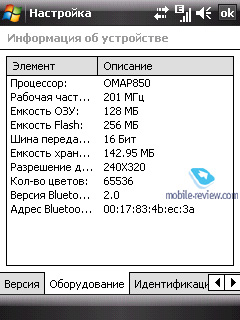
The P3470 ships with 128 Mb RAM, out of which around 106 Mb is available for applications and OS needs, though the system files occupy around a third of this volume, so you are down to roughly 70-75 Mb – this should be enough to allow for ten and more applications to run simultaneously on the P3470. Even with 15 running programs, the communicator didn’t freeze up or slow down, and that’s with its seemingly sluggish CPU.
The storage space that the user can manage makes 140 Mb. A couple of megabytes are taken up by preinstalled applications, so eventually you will have around 80-100 Mb at your disposal, meaning that there will be no shortage in this department when it comes to installation of the most helpful and essential applications. And the rest can be thrown onto the memory card.
We have put the P3470 though its paces with the help of the benchmarks built into Core Player. Rates of 100% indicate that videos in the given resolution will be played back without any discernable slow-downs, frames might drop out only during dynamic scenes. And all performance rates better than 120-130% mean that the communicator’s computing power will be enough for perfect playback (no freezes or dropped frames) of videos in the given resolution and quality.
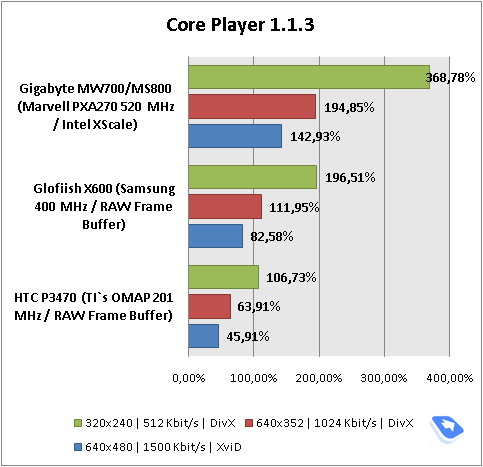
The results came as no surprise to us – the increased memory volume did not improve the CPU's poor video rendering skills. The P3470 may be a way to go if you are into short clips, TV shows, but rest assured, you are very likely to run into serious difficulties (dropped frames, freeze-ups) even with converted videos. Although, if you are into it, you can play around with the video conversion settings to squeeze the maximum out of the P3470.
The P3470 is a decent performer as far as menu and interface speed goes – unlike the previous devices running on the OMAP 850, this communicator is by no means sluggish.
Back to the table of contents >>>
Connectivity
The handset seamlessly taps into GSM (850/900/1800/1900) networks. The P3470 supports EDGE data and Bluetooth for wireless connectivity. For PC synchronization and data transfer purposes you can use the miniUSB cable shipping with the handset, apart from its Bluetooth wireless connectivity. The P3470 employs the obsolete USB 1.1 standard, whose speed only allows uploading a 10 Mb file in 25-30 seconds. For managing all wireless interfaces, the P3470 utilizes an application from HTC’s suite– Comm Manager.
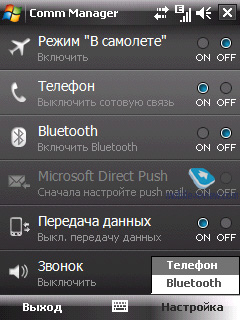
The communicator also comes with Bluetooth 2.0+EDR module and already-standard Microsoft’s drivers. Below is a rundown on the profiles available with the P3470 and their purposes:
- Serial Port Profile (SPP). Emulates COM-connection of devices. Used mainly for synchronization with desktop PC, coupling external Bluetooth-gadgets, like Bluetooth GPS-receiver.
- Object Push Profile (OPP). A basic profile for sending "objects" such as pictures, virtual business cards, or appointment details.
- Headset Profile (HSP). The most commonly used profile, providing support for the popular Bluetooth Headsets to be used with mobile phones.
- Human Interface Device Profile (HID). Connection of Bluetooth-keyboard.
- Advanced Audio Distribution Profile (A2DP). Sound transfer via Bluetooth.
- Audio Video Remote Control Profile (AVRCP). Music playback management via wireless headset.
- Personal Area Network Profile (PAN). Network connection via Bluetooth, use for connection of a desktop PC to Internet through the communicator, replaces Dial-Up Networking profile.
- Basic Printing Profile (BPP). Sends files directly to a printer over Bluetooth.
- SIM Access Profile (SAP). Allows connecting to a SIM card in a phone with Bluetooth, so the car phone itself doesn't require a separate SIM card.
- File Transfer Profile (FTP). Provides access to the file system on another device. This includes support for getting folder listings, changing to different folders, getting files, putting files and deleting files.
We experienced no problems with the P3470’s Bluetooth connectivity – all profiles operated as expected.
The lack of Wi-Fi may put some users off, however the mass market won’t see it as a crucial omission.
Back to the table of contents >>>
Camera
The P3470 enjoys a 2 Mpix (CMOS) camera without autofocus. Among all other things it packs in a smallish self-portrait mirror and a macromode switch (sitting above the lens). The camera’s quality is quite mediocre, being in line with the Glofiish X600, yet better than the HTC Touch and Touch Dual.

The camera interface is similar to those found in the HTC TyTN II and the Touch Cruise, down to the viewfinder mode, where you can access a stand-alone menu to make quick alterations to the camera’s essential settings. It is called up with one tap and removed from the display in a similar fashion. All settings are housed in a semi-transparent menu that pops up on the viewfinder’s screen.
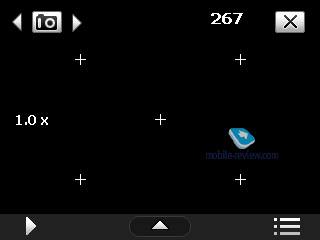
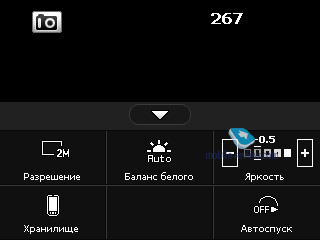
The P3470’s display also rooms all required thumbnails indicating what shooting modes have been activated. The top tow (from left to right) includes: current mode (still image, video, MMS video, sport, and portrait, multishot) and the number of shots left. All other options are available from the panel at the base of the screen that can be brought up by tapping it:
- Current image resolution
- White balance
- Exposure settings
- Storage place (internal memory, memory card)
- Self-timer
Looking to the left you will find the zoom bar, so to zoom in all you need to do is press one of the navigation pad’s directional keys (up or down) or just pick the zoom icon.
While capturing video, you can utilize only 2x zoom. Read on to find more about the P3470’s video recording capabilities.
The following image resolutions are available:
- 2 M – 1600x1200
- 1 M – 1280x960
- L – 640x480
- M – 320x240
- S – 160x120
One of this menu’s shortcomings is that you can change the resolution settings only from the viewfinder made and there is no way to find out what resolution you are shooting with, as all you can see are 2M, M, L, S etc.
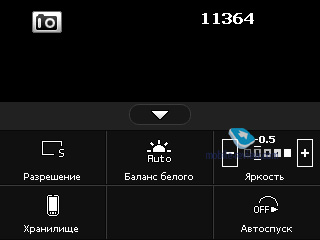
Image quality (for the most part affects image size):
- Super Fine
- Fine
- Normal
- Basic
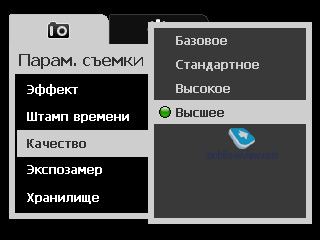
White balance:
- Auto
- Daylight
- Night
- Incandescent
- Fluorescent
Overlays:
- Grayscale
- Sepia
- Cool
- Negative
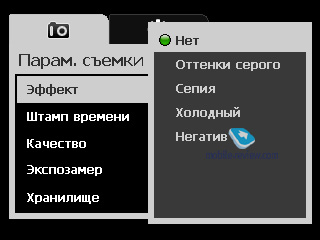
Exposure:
The P3470’s image quality can be adjusted with the help of one of the following settings as well: Contrast, Saturation, Sharpness (all on a 5-point scale). Additionally, you can setup the shutter sound, enable or disable the grid mode, timer, and time stamp.



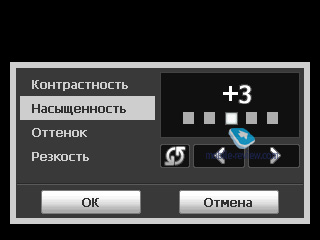
Daylight shots
 |
 |
| (+) maximize, 1600x1200, JPEG |
(+) maximize, 1600x1200, JPEG |
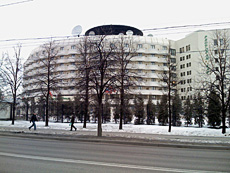 |
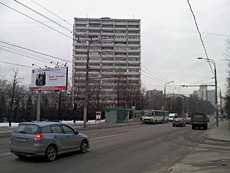 |
| (+) maximize, 1600x1200, JPEG |
(+) maximize, 1600x1200, JPEG |
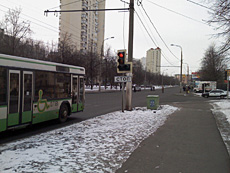 |
 |
| (+) maximize, 1600x1200, JPEG |
(+) maximize, 1600x1200, JPEG |
Indoors shots
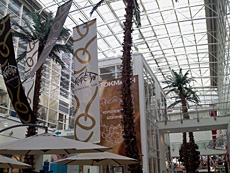 |
 |
| (+) maximize, 1600x1200, JPEG |
(+) maximize, 1600x1200, JPEG |
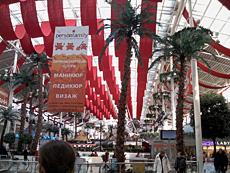 |
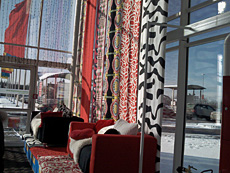 |
| (+) maximize, 1600x1200, JPEG |
(+) maximize, 1600x1200, JPEG |
 |
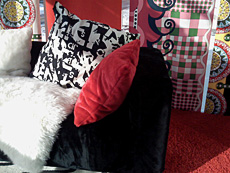 |
| (+) maximize, 1600x1200, JPEG |
(+) maximize, 1600x1200, JPEG |
Night shots
Macromode
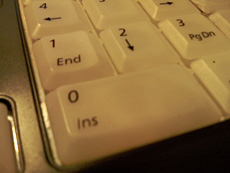 |
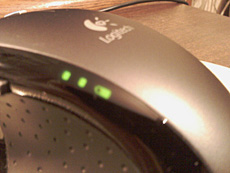 |
| (+) maximize, 1600x1200, JPEG |
(+) maximize, 1600x1200, JPEG |
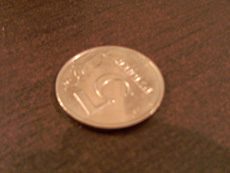 |
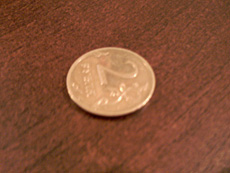 |
| (+) maximize, 1600x1200, JPEG |
(+) maximize, 1600x1200, JPEG |
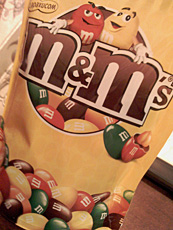 |
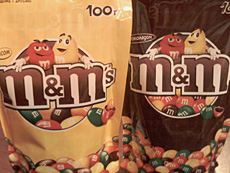 |
| (+) maximize, 1200x1600, JPEG |
(+) maximize, 1600x1200, JPEG |
The macromode found in the P3470 is nothing to write home about, even though it has a dedicated switch mounted on the casing. Objects shot from distances less than 6 cm come out blurry, details get smeared up; the best possible distance for macro with the P3470 is around 10-12 cm.
What is more, texts are nearly illegible when snapped with the P3470 – regardless of the mode you are in, these snaps are very hard to read.
The P3470 records video in MP4 (codecs: mp4 or h.263) at 10 frames per second (bitrate – 50-250 kb/s). Sound is recorded with the sAMR codec at 128 kbps (sample rate – 8000 Hz, mono).
The following video resolutions are available with the communicator:
- Normal – 176x144
- Small – 128x96
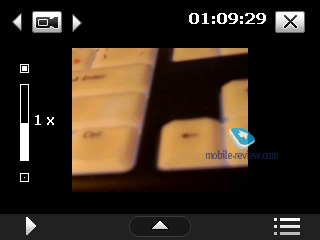
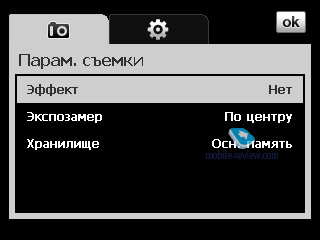
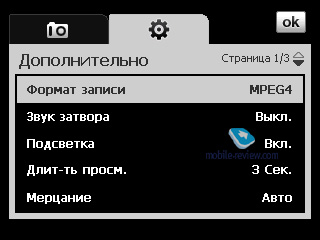
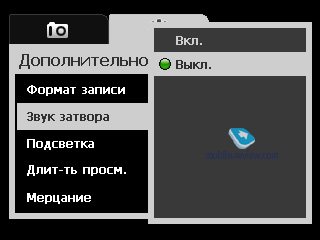
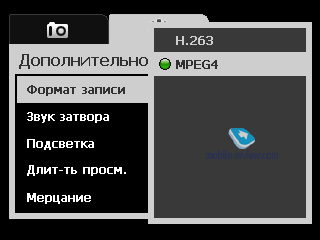
The settings adjustable in the camcoder mode are no different from those for still images, useful extras here include: sound recording (on/off), clip duration/size limits.
Indicating what league the P3470 is in video-wise are the list of available resolutions and FPS – obviously with only this onboard, the communicator can pull off no miracles.
Generally, there are no size or duration limits for video files to be observed. However you can always opt for shorter clips so as to send them in multimedia messages (MSS mode).
On balance, the HTC P3470’s camera is more of a makeweight – it hasn’t really changed since the P3300’s release and certainly doesn’t have the right to be on your wish-list for the P3470.
Back to the table of contents >>>
GPS navigation
The handset comes installed with the SiRF Star III GPS-chipset, although all spec sheets for the P3470 either have no chipset info or feature the protocol name instead - NMEA 0183. By and large, the SiRF Star solution is utilized by many navigation-savvy communicators; on this front, the HTC P3470’s numbers were: cold start time of 1,5 minutes (provided that you have uploaded auxiliary data on satellites via QuickGPS), all subsequent sessions required us to wait 10 to 25 seconds (outdoors) to get a GPS fix on our location.
The P3470 precision and signal reception quality were never an issue; the communicator did a good job plotting our route, without any substantial deviations; however at slow speeds signal may drop off for a few seconds, but you won’t notice these breakups at all, plus they don’t affect the precision of navigation.

(+) maximize image

(+) maximize image
We gave the P3470 a run-through with iGo and TomTom Navigator 6, as well as Google Maps and experienced no problems with any of them.
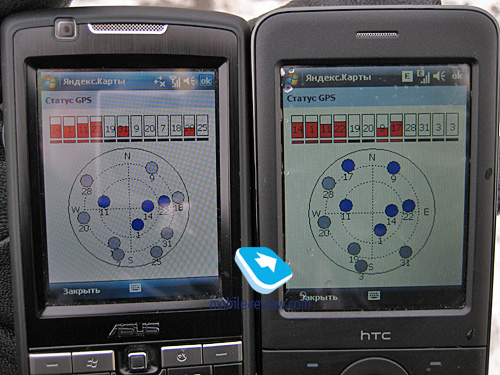
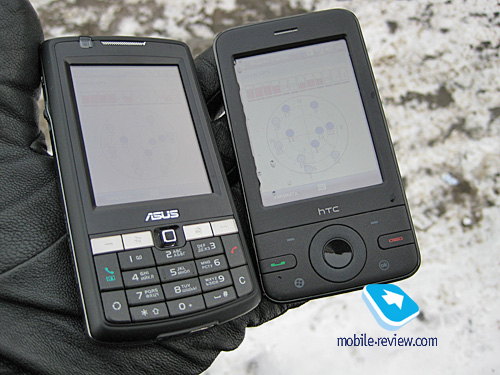
The communicator comes preinstalled with the QuickGPS utility for updating satellite data once in two days.
The HTC P3470 also ships with CoPilot Live navigation software that allows downloading one map of your choosing for free. All core abilities of this utility are pretty much in line with other programs serving the same purposes, i.e. iGo, TomTom. The major differences include the application’s interface and the way it renders maps.
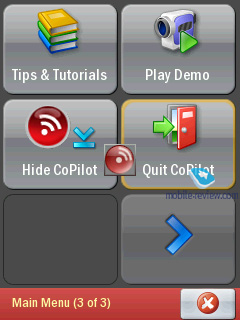
The communicator doesn’t come boxed with any accessories for in-car use, meaning that you will have to get them separately – the kit including all the essentials will arrive at one time with the P3470 and will retail for around 50-60 USD.
Back to the table of contents >>>
Software
The communicator runs on Windows Mobile 6 Professional. To learn more about the standard feature pack shipping with this operating system, go to our dedicated review, and now let’s get straight to its extra applications.
Java – emulator for applications written on Java. Its capabilities are very limited; in light of this fact 3D Java is not supported. In most cases support for Java-powered applications is not called-for on smartphones and communicators, since these days there are tons of applications for Windows Mobile out there. Some users make an exception for OperaMini as this app is simply the winner in the save-my-traffic contest. Another example - for Java-games addicts who need such an emulator badly. However the default emulator does not support additional libraries used for creation of Java applications for Nokia-, Motorola-branded and some other handsets. Hence nobody guarantees these applications will launch and operate properly.
Zip – HTC’s very own utility for handling archived files – you can extract data from an archive, or add new to an already existing compressed file.
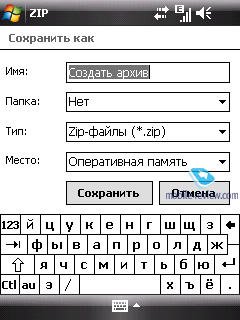
Adobe Reader LE – is the most widely adopted application for viewing PDF documents, and this is its mobile edition. Much like its elder brother, the application never seems to be in a hurry. Loading a page takes about 10-15 seconds, should the document contain a considerable number of schemes and pictures each page will load for half a minute or even longer. It should be noted that as far as small files are concerned, the viewing capabilities this application provides, are more than sufficient.
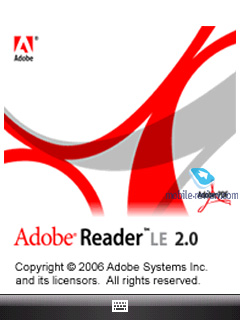
Voice recorder – the most basic application for recording voice clips; doubles as a player for playing back the recordings you made, all sound clips can be set as call alerts. Also using this app you can record all incoming and outgoing calls (records both ends).
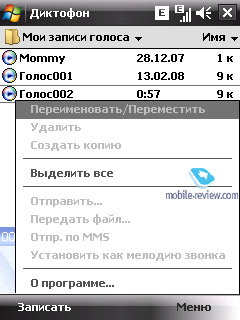
Voice dial – self-explanatory application requires voice training, in other words, voice tags for specific contacts. However it does a pretty decent job, so having dealt with its settings once, you will never have to resetup it ever again.
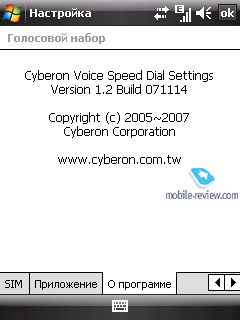
Connection wizard – a very simple utility that offers you to setup Internet and SMS profiles on starting the communicator for the first time. You are free to get back to it at any time, plus it automatically launches every time you swap SIM cards.
RSS Hub – a new application that made its first appearance with early prototypes of the HTC Touch Cruise’s firmware. The P3470 comes with the full version. While its name is quite self-explanatory, it packs in a bevy of settings, allows adding news feeds separately and import entire lists from *opml-files (with the *xml extension). You are also allowed to import news feeds from Google Reader and most other programs by extracting their feeds into a supported file type.
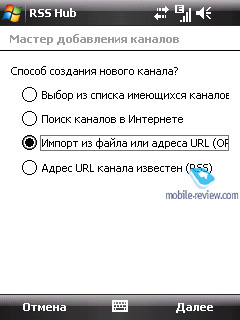
The application enables the user to setup key words for tracking all news items containing them. For example, you can submit “HTC” and assign it to some icon, after that all news posts with “HTC” in them will be marked with this icon.
The utility offers a plug-in that enables notifications about new items in your feed (as well as the number of news containing the key words) on the Today screen. The only letdown, or, let’s put it this way, awkward feature characterizing this type of applications – when attempting to read a news item, RSS Hub starts up the communicator’s browser for this purpose.

TouchFLO
This technology, debuted with the HTC Touch, has been carried over to the new communicator along with HTC Home and it is good to know that the P3470 comes included with this welcome feat. All constituents and features of the TouchFLO technology, including the three-facet UI, are enabled in the HTC P3470 (scrolling in lists, phonebook etc), making it so much more appealing that the P3300; in fact, it is one of the key items in its change log.
Along with the interface, HTC offers a handful of custom applications keyed to the menu appearance for handling multimedia content and tweaked for gesture-centric navigation.
Audio Manager – application similar to the standard Media Player. In terms of the abilities this app doesn’t differ from the built in player, saving for the interface.
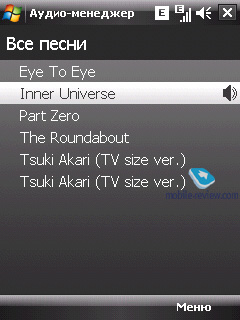
However HTC’s own application packs tools for basic track editing, like cutting fragments so as to set them as ring tones afterwards. Now this operation can be performed hands down, even a newcomer won’t have any problems with doing that – you pick a track, specify the fragment you need (in seconds or on the progress bar). For example, you can select a 6-minute long song and take 30 seconds out of it by cutting off 2 minutes from the beginning and 3,5 minutes before the end.
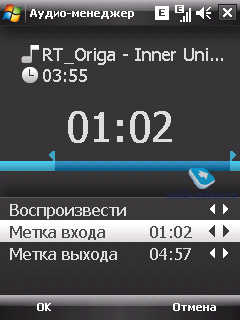
Image gallery
For you image viewing needs, HTC has come up with a pretty unsophisticated application, and by this we mean its very intuitive and straightforward interface and of course its focus on finger-based navigation.
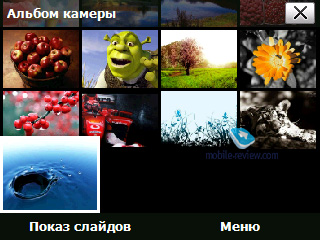
But as far as functionality is concerned, this application is no revolution when thinking of the Apple iPhone’s authority on the market. Essentially, HTC has employed the most user-friendly parts of the iPhone’s interface in its latest and greatest models. For the Image gallery, these amenities include gesture-based navigation through your pictures and ability to zoom in and turn photos with your finger tips.
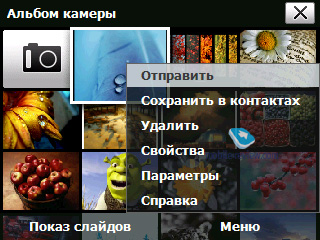
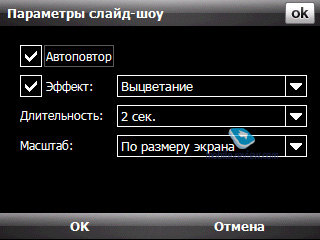

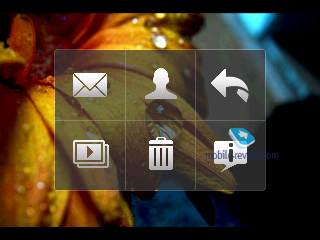
The application’s home screen features thumbnails that you can page through using your fingers or the navigation pad. Hovering over a particular thumbnail will slightly enlarge it.
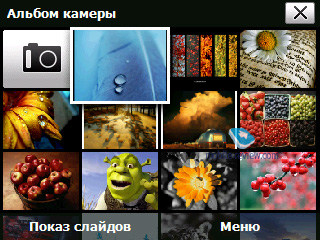
In full screen mode you can scale or rotate images with certain gestures.
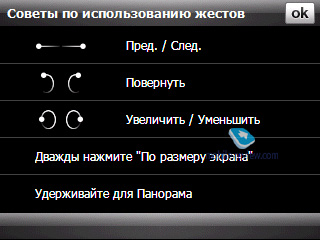

Apart from that, the P3470 allows its user to view pictures as a slideshow, send a selected image via mail or MMS.

HTC Home
The HTC P3470 benefits from the latest version of the custom Today screen add-on, featuring 5 tabs: shortcuts to 9 applications and settings, weather, time, sound profiles and 9 contacts for quick dial. All five tabs are still arranged in a horizontal line and can be navigated with a stylus or finger. The tab that changes the current sound profile offers the following options: loud, quiet, vibro, no sound, calendar-dependent.

The service bar topping the display has acquired a size boost, meaning that while previously you had to tap precisely one of the tiny icons you needed to interact with it, this time around all it takes is a tap on the top part of the screen, then you can choose any of the available options from the enlarged version of the menu.

The Start menu can be viewed as a standard pop-up window or a panel with bigger fonts, making for friendlier finger-based navigation – in the latter case, on calling it up, the display’s top part will feature recent applications, which was previously available you for landscape screen layout.
Upon picking the Task Manager on the home screen you see a drop-out menu with currently running applications and large “Close” buttons standing to the right of their names. This menu’s top shows you how much RAM is in use, Close All and Settings buttons.
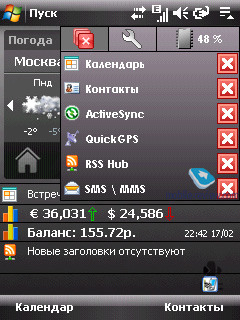
Tap on the percentage icon to jump to the Memory Settings menu.
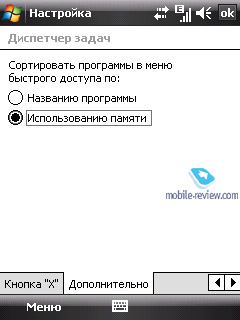
The contact list can now be sorted by photo ID, although in our unit this filter did a poor job, picking around 5-6 entries out of around three dozens that had a picture assigned to them.
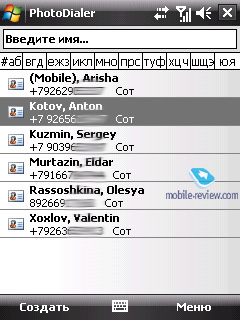
Calling features
The handset comes installed with a thorough overhaul application for handling calls – a similar version is found in the HTC Touch Dual. To call it up, tap the corresponding icon at the foot of the Phone application (which pops up once you punch the Send button)
There are four tabs sitting at the bottom of the Calls menu, each standing for a particular type of calls: outgoing, incoming, missed, all active incoming and outgoing calls (during which you actually talked). Every menu features caller’s name and phone number, as well as call time. And much like other menus, all icons here are big enough to make navigating them with fingers a snap.
This menu also offers all standard filters (although they are of no use), and information on all calls.
If you make or receive a call from someone who is not on your Contact list, after hanging up you will see a prompt offering you to save that unknown number in the phonebook. After this all you need to do is tap Yes and the communicator will create a new entry with the Phone Number field already filled in, so that you will only need to type in name and other data.
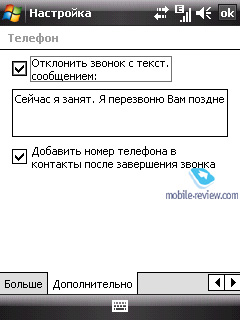
Apart from allowing the user to save unknown numbers in the Contact list, with the P3470’s settings you can setup auto-reply with SMS, when you reject a call, and adjust some other useful settings.
The P3470’s Quick Menu is called up by holding down the End button. You can reprogram this key’s long-press to do some other things, like lock the keypad or switch the communicator in the Flight mode. The Quick Menu also allows users to enable the Flight mode, Silent profile, keypad lock or interrupt a data session.
Data input
The HTC P3470 comes equipped with three software keyboards – one is pretty much standard, two others have been brought about by HTC (12- and 20-key layouts). The user can benefit by employing the T9 and iTAP systems – when using the former, you press every key only once, so the communicator offers you to pick the right word from the pool it managed to come up with; for the latter mode, the T9 gets disabled; and when typing without either of them, the P3470 just offers you to pick one of the words you entered in your previous messages.
The iTAP can’t be disabled, though – it works even when utilizing the operating system’s standard keyboard, which isn’t a bad thing – it does a good job unobtrusively offering possible words endings once you’ve entered first few letters. If they are not what you’re looking for, then just pay no attention to them and carry on.
The P3470 allows you to use all three keyboards when conducting a search in the phonebook; however the HTC’s solutions feel quite awkward there, since they take up almost the entire screen and actually bar contact names.
The looks of all these on-screen keyboards are in keeping with the communicator’s style code, and what is more, they house sizable keys, which make for easier texting with the P3470.
Back to the table of contents >>>
Competition
Being a follow up to the HTC P3300, the P3470 was designed with the mass market in mind (looks, materials, usability). It is an open secret that the P3300 used to be the etalon for many manufacturers, and nearly each and every player in the Windows Mobile market released a rival to it. That’s why there will be no shortage of competition for the P3470, but we are rather willing to give a close-up to the most potent of the.
Mitac Mio A502. Spec-wise it is very close to the P3470, yet comes with less RAM onboard. Neither of the communicators packs Wi-Fi, both run Windows Mobile 6 and are positioned as navigation-savvy solutions. Mio’s device is a tad more pocketable, plus sports a superior camera and accessories for in-car use packaged in its box, but that’s about it – as far as easy of use, ergonomics and software enhancements go, the P3470 is a clear-cut choice for those who want a GPS-enabled communicator with all gears spinning right out of the box.
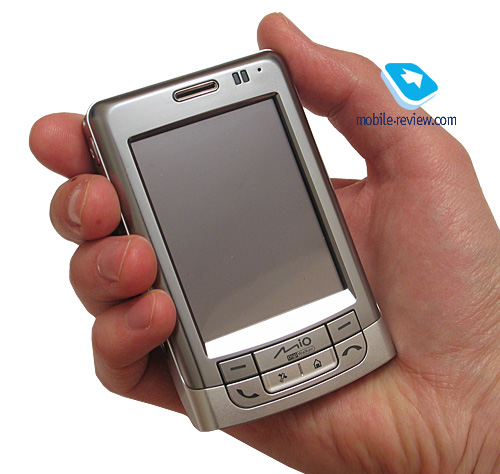
But when it comes to price, the Mio A502 pulls its main trump out of its sleeve – it is almost 1.5 times cheaper than the P3470 at 380 USD. So if it gets proper distribution and press, the A502 may well become a passable alternative to the P3470, although with some reservations. Yet again, those who want to get maximum usability and value for their money, will find the HTC P3470, largely thanks to its software add-ons, a better way to go.
Glofiish X600. E-Ten’s solution trumps the P3470 in terms of functionality, boasting Wi-Fi, radio, faster CPU, which, however, doesn’t make any difference given those 64 Mb of RAM it packs in – effectively, it is no speedier in applications/navigation than the HTC P3470 with its 200 Mhz and 128 Mb RAM.
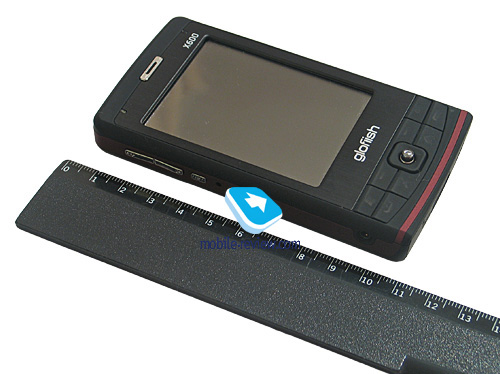
Design- and ergonomics-wise, these two are pretty much in one league – Glofiish benefits from offering two color schemes, while HTC offers better materials. As far as software goes, much like in the case of Mio, the P3470 is unrivalled, being miles easier to master and make use of thanks to the improvements made to the default UI of the operating system.
Since the X600 and the P3470 bear nearly identical price tags, the key factors you should be basing on are design and whether you have time and desire to come to grips with the OS. If the latter is not an option, then the P3470 is a smarter choice; otherwise they are pretty much equal.
Gigabyte MW700. The sales of this communicator kick off in February, about the same time the HTC P3470 hits the shelves. While it retails for the nearly the same money, the MW700 outruns the P3470 in terms of features (Wi-Fi, video-ready Marvell’s CPU, radio). But in terms of materials and wow-effect, it is still far behind the P3470.
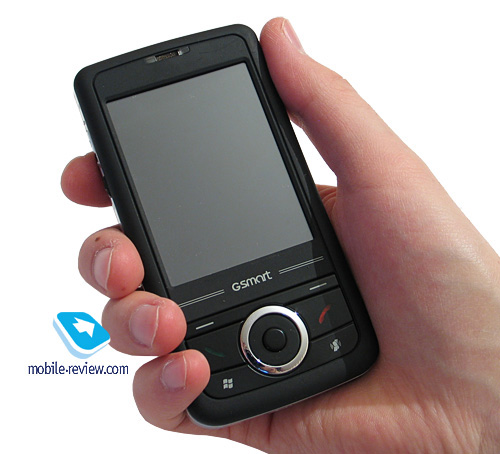
All up, the MW700 ends up in one line with the Glofiish X600, as both of them are quite interesting solutions, both have some goods under their hoods, but as far as the mass market goes, they have no shot against HTC’s software enhancements that have been carried offer from more high-end solutions.
Asus P526. In terms of functionality, this communicator is as close to the P3470 as it gets, but it also comes with 64 Mb RAM and a number bad. The P526 has no Wi-Fi. While it is 80-120 USD cheaper than the P3470, it comes with resembling materials and design. All in all, it should appeal to those looking for a more feature phone-esque communicator.
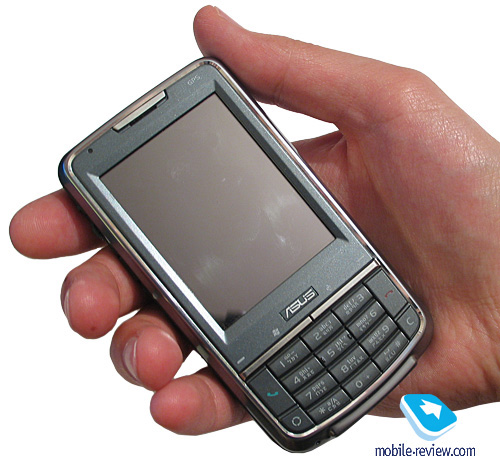
Back to the table of contents >>>
Conclusion
The reception quality was never an issue with the P3470 – our calls were pretty loud, although we could use some more volume for call-unfriendly environments. The loudspeaker is slightly above average volume-wise, meaning that it is likely to get to you while on a busy street. The vibro alert is moderate in terms of strength.
The communicator is set to arrive in early/mid May at a price point of 550-600 USD, which is what the still-on-the-market HTC P3300 costs. While a lot of things about these two communicators are similar, they still different in a couple of major ways:
- New OS version – Windows Mobile 6
- 128 MB RAM (64 Mb in the P3300)
- Revamped design
- Better materials
- Black color (the P3300 is available only in grey)
- Pressable navigation wheel on the front fascia
- Conventional button instead of the trackball
- Macromode-enabled camera
- Software enhancements (calling features, HTC Home)
- Finger-based navigations (TouchFLO)
The list of what they have omitted is pretty short, though:
- No Wi-Fi
- No FM-radio
- No car-kit and car charger in the sales package
Is the P3470 a worthy replacement for your HTC P3300, or it’d be better to wait for the Touch Cruise and take it instead? If you really crave for Wi-Fi, then it is pretty much your only option as far as HTC’s portfolio goes. In all other cases, however, the P3470 is the best communicator you can get to finally make your P3300 retire. The P3470 improves a ton on almost all fronts, plus it is easier to use and speedier in standard applications, navigation and menus.
The launch of the P3470 may spark an argument on whether this sort of update is okay, when it is nothing but a revamp of the previous solution. But HTC is on the right way – they are enhancing the features that the mass market covets, which will allow the P3470 to sell almost as well as the P3300, plus it will have one of the longest life spans in HTC’s range. At first it will be positioned as a replacement for the P3300, and then will get pushed down to the niche with entry-level GPS-enabled communicators.
Specifications:
- Type: communicator
- Form-factor: candybar
- Competition: Mio A502, Glofiish X600, Gigabyte MW700, Asus P526
- Position in the line-up: above the P3300
- Materials used: plastic, soft-touch, metal
- Operating system: Windows Mobile 6 Professional
- CPU: TI’s OMAP 850 200 MHz
- RAM: 128 Mb (~106 Mb available)
- ROM: 256 Mb (~140 Mb available
- Connectivity: microSD (SDHC), Bluetooth 2.0+EDR (A2DP), USB 1.1 for charging/synch/headset
- GSM: 850/900/1800/1900, GPRS/EDGE
- GPS: SiRF Start III
- Display: TFT 2.8” with a resolution of 320x240 pixels, shows up to 65 K colors
- Camera: 2 Mpix, macro mode, self-portrait mirror, 176x144-pixel video recording
- Battery: detachable 1100 mAh Li-Ion
- Dimensions: 108 x 58.3 x 15.7 mm
- Weight: 122 g (with battery)
Back to the table of contents >>>
Artem Lutfullin (artem.lutfullin@mobile-review.com)
Translated by Oleg Kononosov (oleg.kononosov@mobile-review.com)
Published — 04 March 2008
Have something to add?! Write us... eldar@mobile-review.com
|
